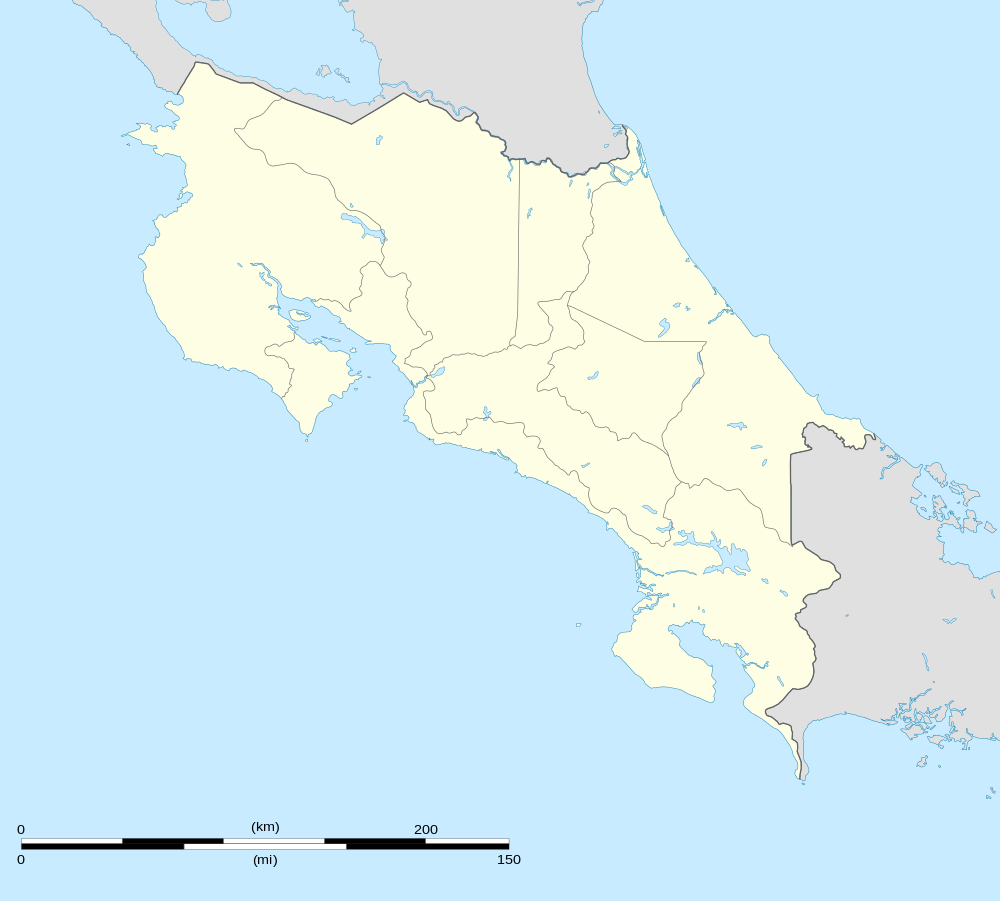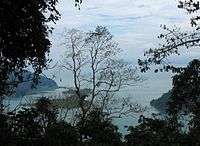Golfito
| Golfito | |
|---|---|
|
A view of Golfito bay from the hill behind Golfito town, with Playa Cacao to the right and the Golfo Dulce in the background (beyond the peninsula) | |
 Golfito Location in Costa Rica | |
| Coordinates: 8°38′N 83°15′W / 8.633°N 83.250°W | |
| Country | Costa Rica |
| Province | Puntarenas Province |
| Canton | Golfito |
| Elevation | 62 m (203 ft) |

The port town of Golfito (literally 'little gulf') is located in Puntarenas Province on the southern Pacific Coast of Costa Rica, near the border of Panama. The town lies on a narrow strip of land between the eponymous bay and a hill and consist of two parts, the town proper and shopping area to the south, and a residential area near the port. Still further north are the duty-free zone and an airstrip.
Geography
From the northern section, which was the old United Fruit Company headquarters, trails go up to the Refugio Nacional de Vida Silvestre Golfito (Golfito Wildlife Refuge) on the hill, which extends across to the other side of the bay and is part of the National Parks of Costa Rica. With some of the highest storied rainforests in Central America (30–45 metres), most of the coastal lowlands surrounding the town are characterized by tall evergreen forest. The region receives an annual average of 400–500 centimeters of rainfall.
Golfito Bay (an English misnomer because it means 'little gulf bay') is within the larger Golfo Dulce, and separated from the open Pacific Coast by the famous Osa Peninsula. Frequent ferry boats cross the Golfo Dulce from Golfito to Puerto Jimenez, which is the primary access point for the Osa Peninsula and the splendid Corcovado National Park, one of the few remaining sizeable areas of lowland tropical rainforest in the world.
Economy
In the mid 20th century, Golfito was a major banana growing region (also resulting in it being the major port of southern Costa Rica), but a combination of worker unrest, declining foreign markets, rising export taxes and banana disease led to the closing of the United Fruit Company in 1985. African palm oil plantations replaced all the old banana plantations and, due to its success, more and more land is devoted to grow this palm. A small flow of tourists began to arrive in the mid-1990s, and by mid-2006 sport fishing has become the most important tourist attraction. The Duty Free Shopping Centre (Deposito Libre Comercial de Golfito) (really 'lower tax') has attracted shoppers from other regions of the country, helping the local hospitality business.
The beaches in the region are some of the most beautiful in the country. Calm water provides for many peaceful tourist activities, even during the tide fluctuation, which averages about 3 metres (9 feet).
Education
The town of Golfito has 5 primary schools (1st - 6th year), one secondary school (7th - 12th year) that also offers a separate night schooling. The University of Costa Rica has a branch campus in Golfito where students mostly from the "Zona Sur" region attend. As a public university, UCR-Golfito offers scholarships and housing to about 90% of its students. UCR-Golfito has student housing facilities (called Bachers), a library, laboratories, and a student union called Club Centro, where art and recreational activities take place.
Fishing and boating
The town offers small marinas, yachting and boating services, sport fishing, and a destination for cruise ships. Much of the tourism in the Golfito area focuses on the sport fishing industry. Many of the lodges and hotels have their own sport fishing fleets and experienced boat captains. Yachting, boating, water sports and beach activities are also popular pastimes. The beaches south of Golfito — Playa Zancudo, Pilon and Pavones — offer excellent surfing. Easy and safe water approach make it a relaxing place to stop and check in or out of Costa Rica when sailing.
The approval of permits for construction of a new big marina in Golfito has been a process that lasted over nine years, not without controversy. Environmentalists and local residents opposed this project because of environmental concerns. Among the many issues are: the lack of a scientific study to determine the actual environmental impact due to antifouling paint, coliforms, and oil spillage; and, the lack of space to install a water treatment plant. The Regulatory Office for Marinas in Costa Rica (CIMAT) ordered the Golfito Municipality, in early 2010, that all permits for this marina project must be withdrawn.

Coordinates: 8°38′04″N 83°09′43″W / 8.634316°N 83.161869°W
